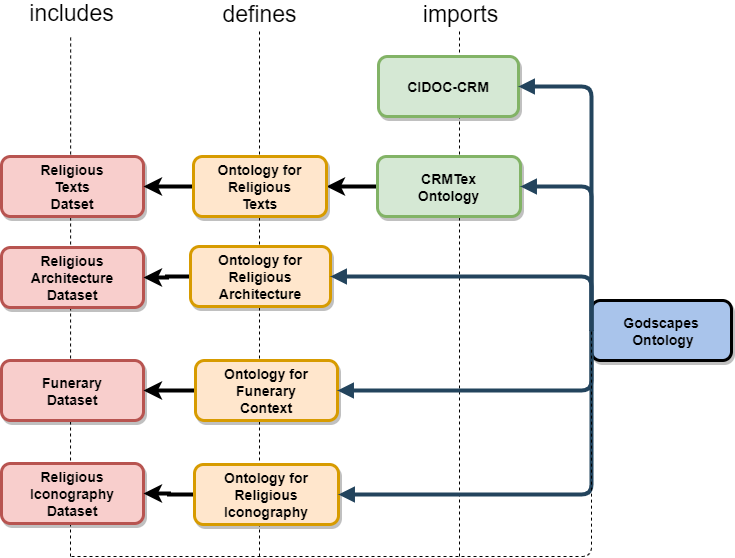

Modeling ancient religions via
SEMANTIC WEB ontologies
Methodology
The methodology here proposed will move towards an approach that will not focus only on one aspect of the material culture, but instead it will be based on a methodological approach that envisions the entanglement of things with humans and with ideas in the construction of religious beliefs and practices. In fact, connecting different aspects of human life and knowledge widens the perspective of analyzing religious phenomena bringing about a more coherent study of the elements involved in its construction through a focus on religious practices.
purposes
The research project Godscapes will follow this scientific path and will aim at creating a model that can clearly define how material elements of religiosity are related to each other in moments of cultural transformation. In particular, the research here proposed will try to answer fundamental research questions using a long-durée perspective, such as:
mAIN TASKS
Our approach will be based on deconstructing the elements recognizable in four fundamental aspects associated with material religiosity that will characterize four of the main tasks of our research agenda and are:
1) religious architecture;
2) religious iconography;
3) funerary rituals/beliefs;
4) religious texts.
This work of deconstruction will be done through the application of an epistemological process in which a suite of semantic web ontologies is designed, implemented, linked to the most popular semantic web vocabularies and datasets in the field.
SEMANTIC WEB
The semantic web is a vision of the web in which machine-readable data enable software agents to query and manipulate information on behalf of users. In such a vision, web information carries an explicit meaning, so it can be automatically processed and integrated by machines, and data can be accessed and modified at a global level, resulting in increased coherence and dissemination of knowledge.
In the context of the semantic web, an ontology is a formal, shared and explicit representation of a conceptualization of a domain of interest. More specifically, it is a first-order axiomatic theory that can be represented in a description logic. Representational primitives of an ontology are typically classes (or sets), attributes (or properties), and relationships (or relations among class members). Thanks to several desirable characteristics of these primitives, such as generality and rich expressive power, ontologies have been adopted in the ambit of the semantic web, as a main reliable tool for knowledge representation. Ontologies also play a key role in the integration, analysis, visualization and retrieval of huge amounts of data drawn from different sources and contexts, disseminated in different and often isolated places, and contribute to rendering such data global entities publicly reachable on the web. Moreover, being ontologies representable in decidable description logics, several dedicated automated reasoning tools allow one to prove the consistency of conceptual models and to extract implicit information present in data to gain a deeper knowledge of the application domain at stake.
ONTOLOGiCAL LANGUAGE
Applications that need to automatically process information, instead of just presenting it to humans, require an appropriate ontological language with a formally defined semantics. The goal of such a language should be to simplify machine interoperability of information content by providing additional expressive power along with a formal syntax and semantics. This task turns out to be particularly sensitive in the case of the web and of distributed content. For this purpose, the W3C defined Web Ontology Language 2 (OWL 2), a semantic web language based on a decidable description logic, designed to represent rich and complex knowledge about things, groups of things, and relations between things.
As mentioned before, we plan to define a suite of OWL 2 ontologies, each describing one of the four principal characteristics associated with material religiosity, namely: religious architecture, religious iconography, funerary data, and religious texts, together with their related epistemological analysis, thus resulting in an unambiguous and shared formalization of the religious concerns.
FOR EXAMPLE:
Populating these web ontologies with such a broad number of published data (ca. 10,000 entries) will allow researchers to query globally interconnected knowledge in an effective way. In fact, such a result cannot be achieved using traditional relational databases. Indeed, relational databases, even though well-assessed tools for organizing and querying information, do not support global data and flexible integration mechanisms with other sources of knowledge and therefore suffer from limited modelling and reasoning capabilities. Such limitations are particularly relevant in the context of the present project, where data of different nature, deeply and intricately interconnected, are collected from different sources of knowledge, contexts and disseminated in a wide geographical area. This makes it difficult to gather, collect, and integrate comparable information. Moreover, application domains often present interesting implicit information that researchers cannot gather immediately when standard relational databases are adopted, but that can be deduced from the available data, if an appropriate tool for automated reasoning is provided.
RESULTS
The resulting datasets will be available publicly in open format to simplify the integration with ontologies for different domains, and to extend the modelled knowledge. As a last step, we will formalize in the semantic web query language, sets of rules in order to characterize specific concepts such as the one of “religious elements” (i.e., “exogenous religious element” and/or “indigenous religious element”); as well as to answer research questions such as, for example: how exogenous elements transformed autochthones forms of religiosity? which are those religious elements that persist and those that are abandoned in Levantine traditions? Finally, in order to query and visualize data in a human-friendly style, the knowledge base so constructed will be accessed by means of an adequate web platform and geographical data also through a WebGIS interface.
